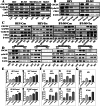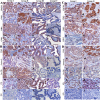Different p53 genotypes regulating different phosphorylation sites and subcellular location of CDC25C associated with the formation of polyploid giant cancer cells
- PMID: 32393310
- PMCID: PMC7212590
- DOI: 10.1186/s13046-020-01588-w
Different p53 genotypes regulating different phosphorylation sites and subcellular location of CDC25C associated with the formation of polyploid giant cancer cells
Erratum in
-
Correction: Different p53 genotypes regulating different phosphorylation sites and subcellular location of CDC25C associated with the formation of polyploid giant cancer cells.J Exp Clin Cancer Res. 2024 Aug 17;43(1):229. doi: 10.1186/s13046-024-03155-z. J Exp Clin Cancer Res. 2024. PMID: 39154162 Free PMC article. No abstract available.
Abstract
Background: Our previous studies have confirmed that cobalt chloride (CoCl2) can induce the formation of polyploid giant cancer cells (PGCCs), which is the key to the heterogeneity of solid tumors. PGCC formation is closely related to the abnormal expression of cell cycle-related proteins and cell fusion. In this study, we investigated the molecular mechanism of PGCCs formation by detecting the expression of cell cycle-related proteins in mutant and wild-type p53 cancer cell lines.
Methods: HEY, BT-549, SKOv3 and MDA-MB-231 cells were treated with CoCl2 and the cell cycle was detected by flow cytometry. The expression and subcellular localization of cell cycle-related proteins, kinases, and P53 were compared before and after CoCl2 treatment. Immunoprecipitation was used to analyze the interacting proteins of pCDC25C-Ser216 and pCDC25C-Ser198. The clinicopathologic significances of these cell cycle-related proteins and protein kinases expression were studied.
Results: CoCl2 induced the formation of PGCCs and G2/M arrest. CDC25C, cyclin B1, and CDK1 expressions after CoCl2 treatment were lower than that in control cells. Cytoplasmic CDC25C was degraded by ubiquitin-dependent proteasome. The expression of P53 and phosphokinases including CHK1, CHK2, PLK1, and Aurora A increased after CoCl2 treatment. The expression of pCDC25C-Ser216 and pCDC25C-Ser198 depended upon the genotype of p53. The expressions of cell cycle-related proteins and kinases gradually increased with the development of ovarian cancer and breast cancer.
Conclusion: CHK1, CHK2-pCDC25C-Ser216-cyclin B1-CDK1, and Aurora A-PLK1-pCDC25C-Ser198-cyclin B1-CDK1 signaling pathways may participate in the formation of PGCCs and different phosphorylation sites of CDC25C may be associated with the genotype of p53.
Keywords: CDC25C; Cell cycle-related proteins; Phosphorylation; Polyploid giant cancer cells; p53.
Conflict of interest statement
The authors declare that they have no competing interests.
Figures






Similar articles
-
Association and clinicopathologic significance of p38MAPK-ERK-JNK-CDC25C with polyploid giant cancer cell formation.Med Oncol. 2019 Nov 16;37(1):6. doi: 10.1007/s12032-019-1330-9. Med Oncol. 2019. PMID: 31734829
-
The subcellular location of cyclin B1 and CDC25 associated with the formation of polyploid giant cancer cells and their clinicopathological significance.Lab Invest. 2019 Apr;99(4):483-498. doi: 10.1038/s41374-018-0157-x. Epub 2018 Nov 28. Lab Invest. 2019. PMID: 30487595
-
PLK4 is a key molecule in the formation of PGCCs and promotes invasion and migration of progeny cells derived from PGCCs.J Cancer. 2022 Jul 18;13(9):2954-2969. doi: 10.7150/jca.74211. eCollection 2022. J Cancer. 2022. PMID: 35912011 Free PMC article.
-
Regulation of the G2/M transition by p53.Oncogene. 2001 Apr 5;20(15):1803-15. doi: 10.1038/sj.onc.1204252. Oncogene. 2001. PMID: 11313928 Review.
-
The role of CDC25C in cell cycle regulation and clinical cancer therapy: a systematic review.Cancer Cell Int. 2020 Jun 3;20:213. doi: 10.1186/s12935-020-01304-w. eCollection 2020. Cancer Cell Int. 2020. PMID: 32518522 Free PMC article. Review.
Cited by
-
Single-cell morphological and transcriptome analysis unveil inhibitors of polyploid giant breast cancer cells in vitro.Commun Biol. 2023 Dec 21;6(1):1301. doi: 10.1038/s42003-023-05674-5. Commun Biol. 2023. PMID: 38129519 Free PMC article.
-
Cells in the Polyaneuploid Cancer Cell State are Pro-Metastatic.bioRxiv [Preprint]. 2024 Jul 16:2024.07.12.603285. doi: 10.1101/2024.07.12.603285. bioRxiv. 2024. Update in: Mol Cancer Res. 2025 Mar 03;23(3):219-235. doi: 10.1158/1541-7786.MCR-24-0689. PMID: 39071340 Free PMC article. Updated. Preprint.
-
Acetylated-PPARγ expression is regulated by different P53 genotypes associated with the adipogenic differentiation of polyploid giant cancer cells with daughter cells.Cancer Biol Med. 2023 Jan 12;20(1):56-76. doi: 10.20892/j.issn.2095-3941.2022.0432. Cancer Biol Med. 2023. PMID: 36647790 Free PMC article.
-
Polyploid giant cancer cells: origin, possible pathways of formation, characteristics, and mechanisms of regulation.Front Cell Dev Biol. 2024 Jul 11;12:1410637. doi: 10.3389/fcell.2024.1410637. eCollection 2024. Front Cell Dev Biol. 2024. PMID: 39055650 Free PMC article. Review.
-
CDC25A inhibition sensitizes melanoma cells to doxorubicin and NK cell therapy.Cell Death Dis. 2025 Apr 11;16(1):276. doi: 10.1038/s41419-025-07598-w. Cell Death Dis. 2025. PMID: 40216745 Free PMC article.
References
-
- Fei F, Zhang D, Yang Z, Wang S, Wang X, Wu Z, Wu Q, Zhang S. The number of polyploid giant cancer cells and epithelial-mesenchymal transition-related proteins are associated with invasion and metastasis in human breast cancer. J Exp Clin Cancer Res. 2015;34:158. 10.1186/s13046-015-0277-8 - DOI - PMC - PubMed
MeSH terms
Substances
Grants and funding
LinkOut - more resources
Full Text Sources
Medical
Molecular Biology Databases
Research Materials
Miscellaneous

